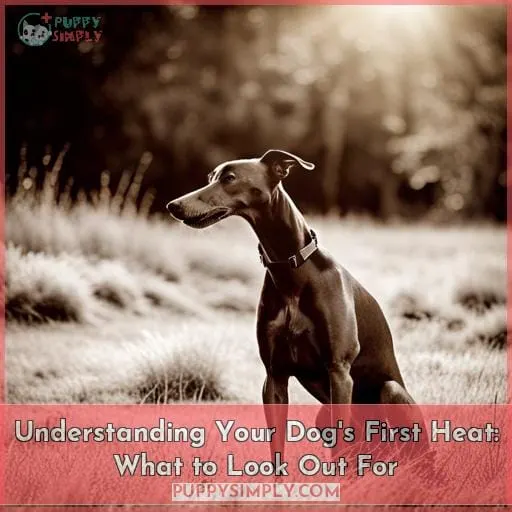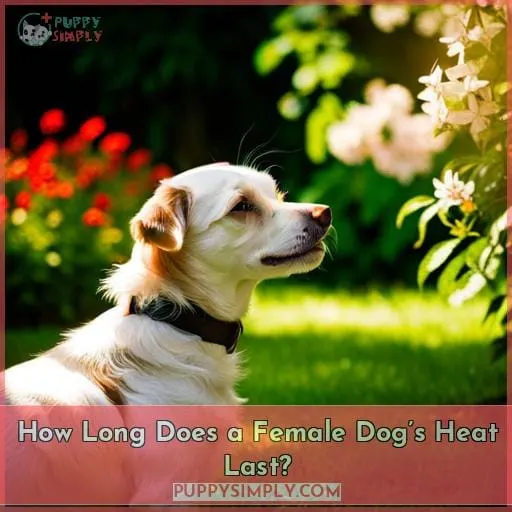This site is supported by our readers. We may earn a commission, at no cost to you, if you purchase through links.
 Befuddled about your pup’s first heat cycle? Don’t be. It can seem intimidating at first, but understanding the basics of canine heats will help you and your dog get through this time with ease. So let’s talk all things female dogs in heat – when it happens, how long it lasts, and what to look out for during her short-term transformation.
Befuddled about your pup’s first heat cycle? Don’t be. It can seem intimidating at first, but understanding the basics of canine heats will help you and your dog get through this time with ease. So let’s talk all things female dogs in heat – when it happens, how long it lasts, and what to look out for during her short-term transformation.
From spotting signs of a dog entering their heat to giving them extra TLC throughout the process – we’ve got everything covered so that you’re prepared for both expected or unexpected developments! Let us take a deep dive into understanding your furry friend’s first heat cycle like an expert pet parent!
Table Of Contents
- Key Takeaways
- What is a Dog’s First Heat?
- When Does a Dog’s First Heat Cycle Come?
- What Does It Mean When a Female Dog is in Heat?
- What Are the Signs a Female Dog is in Heat?
- How Long Does a Female Dog’s Heat Last?
- What Should Owners Know About a Dog’s First Heat?
- How to Care for a Female Dog in Heat?
- Frequently Asked Questions (FAQs)
- Conclusion
Key Takeaways
- Female dogs go through their first heat cycle when they reach sexual maturity, usually between 6-12 months old.
- The average length of a dog’s first heat cycle is shorter than later cycles, lasting around 2-3 weeks.
- Hormonal shifts during this time can cause physical signs like swelling and discharge, as well as behavioral changes.
- Spaying/neutering by experienced veterinarians at a young age is recommended to reduce risks associated with anesthesia drugs.
What is a Dog’s First Heat?
You may be wondering what a dog’s first cycle of maturity is like – and how long it lasts. All female dogs will go through their first heat cycle when they reach sexual maturity, usually between the ages of six to twelve months old.
It is important for pet owners to keep an eye out for any changes in their pup’s behavior before, during, and after her heat. This can help make sure she stays healthy throughout the process. If you are a new pet owner or if your pup has recently come into season, there are some things that you should know about monitoring changes at home, care, spay/neuter options, vet visits, and the average length of her heat cycle.
During a dog’s first season, she may display behavioral signs such as restlessness or increased vocalization. These indicate hormonal shifts in preparation for ovulation. However, these could also be signs of other health issues, so it’s best to consult with your veterinarian if anything unusual arises during this time period.
Additionally, physical changes such as a swollen vulva due to occur prior to ovulation or discharge from nipples indicating lactation can also take place. However, these too require veterinary attention because they might point towards other underlying health conditions not directly related to the reproductive system itself.
It’s always recommended that pets are spayed/neutered by veterinarians who have experience performing those surgeries on young animals. This is especially important since waiting until later age increases certain risks associated with anesthesia drugs used frequently in sterilization procedures.
As far as general care goes, keeping up regular vet check-ups helps ensure everything is running smoothly. At home, diet modifications including adding extra calcium supplements into meals help support proper bone growth development.
Plus, exercise routines like short walks twice daily further promote muscle strength build-up over time.
Keeping track once your furry friend enters puberty isn’t just limited to staying away from unwanted litters. Even though preventing pregnancy remains one of the most common reasons why many people opt for getting puppies fixed early on, there are plenty more advantages to consider aside from reproduction control.
When Does a Dog’s First Heat Cycle Come?
The average length of a pup’s first heat cycle is usually shorter than later cycles. During this proestrus stage, female dogs will experience physical and behavioral changes that signal signs of maturity.
The age factor plays an important role as puppies can enter their first heat anywhere between 6-12 months old, and the duration lasts around 2-3 weeks.
Hormonal shifts during this time period cause certain physical signs such as swelling in the vulva area, lactation from nipples, or even discharge from the reproductive organs itself – all of which require vet attention for further diagnosis if needed.
Spaying/neutering by experienced veterinarians at a young age is recommended to reduce potential complications associated with anesthesia drugs used in sterilization procedures. It also offers plenty more advantages aside from reproduction control, such as diet modifications (including extra calcium supplements) and exercise routines (like short walks twice daily).
Finally, regular vet checkups help ensure your furry friend remains healthy throughout her entire heat cycle process, no matter how long it may last!
What Does It Mean When a Female Dog is in Heat?
When a female dog goes into heat, it’s an important period of time for both the pup and her owner. During this stage, she will experience physical and behavioral changes that can last anywhere from two to three weeks – known as the Proestrus phase.
Heat cycles usually become shorter with age, so an older pup’s first heat cycle may be slightly longer than later ones.
Signs of being in heat include swelling in the vulva area; lactation from nipples or discharge coming out of reproductive organs – all require vet attention if noticed by owners looking after their furry friends’ health during this period for further diagnosis when needed.
It’s highly recommended spaying/neutering by experienced veterinarians at a young age – not only does sterilization prevent reproduction control but also offers plenty more advantages such as diet modifications including extra calcium supplements plus an exercise routine (like short walks twice daily) which help keep your pet healthy throughout her entire process.
Also, regular vet checkups are always a good idea before entering any type of medical procedure, especially one involving anesthesia drugs used during sterilization procedures where body temperature must remain stable all the time, thus ensuring overall safety.
Overall, understanding what it means when a female dog enters her first season helps owners better prepare themselves emotionally & physically while providing necessary guidance & care through the whole process, making sure everything runs smoothly without any issues arising along the way!
What Are the Signs a Female Dog is in Heat?
Signs of being in heat can range from physical changes such as swelling and lactation to behavioral changes like restlessness, so it’s important to be aware of these during your pup’s cycle. Recognizing the signs is key for symptom management and understanding how long her heat cycles will last.
Here are some common symptoms that may occur:
- Swelling in the vulva region
- Lactation or discharge coming out of reproductive organs
- Behavioral changes such as restlessness or vocalization
- Breed differences including a shorter first heat cycle for older pups
It’s important to note that each individual has their own unique cycle duration, with an older pup’s first one usually being slightly longer than later ones. Spaying/neutering should only be done by experienced veterinarians at a young age; not only does sterilization prevent reproduction control but there are also risks associated with spaying which must be considered before proceeding.
For example, diet modifications like extra calcium supplements plus an exercise routine (like short walks twice daily) help keep your pet healthy throughout her entire process – regular vet checkups prior to any medical procedure involving anesthesia drugs used during sterilization procedures ensure body temperature remains stable all the time too!
Understanding what it means when a female dog enters her first season helps owners better prepare themselves emotionally & physically while providing necessary guidance & care through this whole process – making sure everything runs smoothly without any issues arising along the way!
How Long Does a Female Dog’s Heat Last?
On average, your pup’s heat cycle can last for up to three weeks, during which time she’ll experience a rollercoaster of emotions – like riding on an unpredictable wave. Heat cycles are a sign that the female dog has reached sexual maturity, and understanding the changes her body goes through is essential for proper care.
Here are three key points to remember when considering how long a female dog’s heat lasts:
- Breed differences play an important role in determining length. Some breeds have shorter first heats than others due to their size or age at puberty onset. Medium-sized pups tend to enter their first season earlier, while larger ones may take longer before experiencing any signs of being in heat.
- The most obvious sign of a female dog entering her estrus phase is bloody vaginal discharge, but other symptoms such as restlessness, swelling around reproductive organs, and lactation also occur.
- Proper care should be taken from start till end by providing adequate nutrition with extra calcium supplements if needed.
What Should Owners Know About a Dog’s First Heat?
Owners should be aware that their pup’s first heat may have a different duration than subsequent cycles, so it’s important to take extra care and provide proper nutrition during this stage.
During the dog’s first heat cycle, small breed dogs can experience shorter periods of time in heat compared to larger breeds. Heat symptoms generally include restlessness, swelling around reproductive organs, and bloody vaginal discharge, which is an obvious sign your pup has reached sexual maturity.
When considering breeding options for your pet, it’s recommended to wait until after her second or third season before making any decisions. Her body will not yet be fully mature at this point due to hormones still being unbalanced from the effects of her first estrus phase.
It would also be wise for owners to ensure they are prepared with all necessary preventive measures, such as regular checkups and pregnancy tests if planning on breeding their canine companion or allowing them near male dogs when in season – especially since female pups can become pregnant even during their very short initial heats!
Other essential steps for ensuring success include providing adequate nutrition with extra calcium supplements if needed, regular walks twice daily, reducing stress levels through activities like playing music while she sleeps, and monitoring signs of discomfort throughout each step carefully – from start till end!
Breeding Options:
- Wait until 2nd/3rd Season Before Making Decisions
Heat Symptoms:
- Restlessness
- Swelling around reproductive organs
- Bloody vaginal discharge
Reproductive Care:
- Regular Check-Ups & Pregnancy Tests
- Adequate Nutrition with Extra Calcium Supplements
- Regular Walks Twice Daily
- Stress Management Through Activities Like Playing Music While She Sleeps
- Monitoring Signs Of Discomfort Throughout Each Step From Start Till End
- Preventing Unwanted Pregnancies By Keeping Her Away From Male Dogs
How to Care for a Female Dog in Heat?
Providing the right care for a female dog during her heat can be an important part of ensuring her reproductive health and well-being. The duration of a dog’s first heat cycle may be shorter than subsequent cycles, so it’s especially important to take extra precautions at this stage.
Heat symptoms that owners should look out for include restlessness, swelling around reproductive organs, and bloody vaginal discharge – all signs your pup has reached sexual maturity.
When it comes to breeding options, experts recommend waiting until after the second or third season before making any decisions as their bodies will not yet have fully matured due to hormone imbalances from their initial estrus phase.
Here are some essential steps in caring for your canine companion:
- Make diet changes by providing adequate nutrition with added calcium supplements if needed.
- Take them on shorter walks twice daily.
- Reduce stress levels through activities such as playing music while they sleep.
- Monitor behavioral signs of discomfort throughout each step carefully – from start till end!
Other considerations include spaying options and preventing unwanted pregnancies by keeping them away from male dogs when in season using disposable diapers if necessary! With careful consideration given towards these measures together with regular checkups/pregnancy tests prior to planning any breeding advice – owners can successfully prepare themselves ahead when dealing with their pet’s first heat cycle!
Frequently Asked Questions (FAQs)
How often do female dogs come into heat?
Female dogs typically come into heat twice a year. However, their first cycle can be shorter than subsequent cycles and last for as little as two weeks.
Do male dogs have heat cycles?
No, male dogs don’t have heat cycles. Instead, they rely on their instinctive drive to mate when female dogs come into estrus – the period of time when she is ready for breeding and her reproductive organs are receptive.
Is there any way to prevent a female dog’s heat cycle?
Spaying your female dog can prevent her from having a heat cycle. Studies show that spayed dogs live an average of 25% longer than unspayed ones, providing numerous health benefits for your pup.
Does the length of a dog’s heat cycle vary from dog to dog?
Yes, the length of heat cycles can vary from dog to dog. It depends on factors like breed, age, and whether it’s their first cycle or not; often a female pup’s first heat is shorter than subsequent ones.
Take care to ensure your pet has all the nutrition and veterinary support they need during this time.
Are there any health risks associated with a female dog’s heat cycle?
Yes, there are certain health risks associated with a female dog’s heat cycle. It can lead to infections in the reproductive organs and urinary tract, as well as anemia due to the loss of blood. Additionally, dogs may also experience discomfort or pain during their heat cycles.
Conclusion
In conclusion, a female dog’s first heat cycle can vary in length and intensity depending on the breed and individual dog. Generally, a female dog’s first heat cycle is shorter than subsequent ones, so it’s important to be prepared.
With care and proper guidance, you can help ensure your pup’s first heat is as stress-free and comfortable as possible. For those with a female pup, it’s important to know the signs and symptoms of a heat cycle, as well as how to care for your pup while they are in heat.
By being prepared and understanding the basics, you can help make your pup’s first heat a positive experience for both of you.













